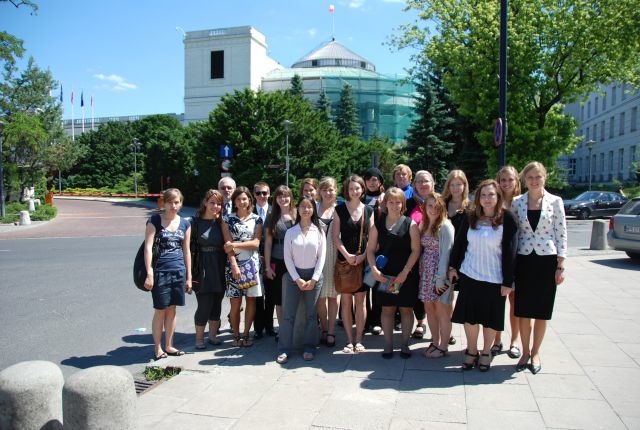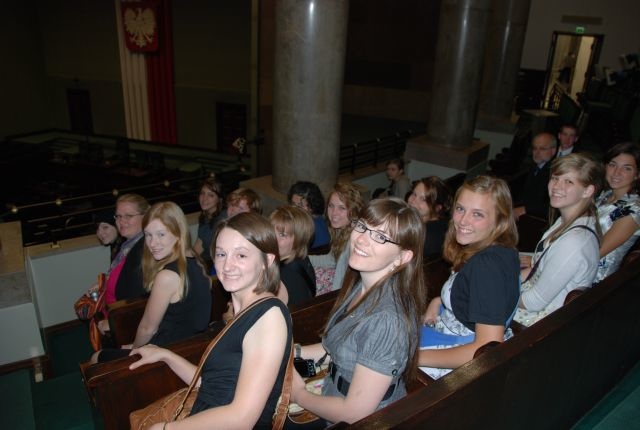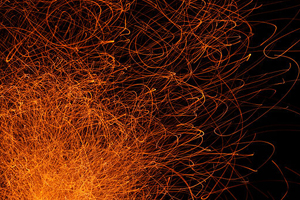 An Interview with Jeanne Briganti and Magdalena Wącisz at the US Embassy in Warsaw
An Interview with Jeanne Briganti and Magdalena Wącisz at the US Embassy in Warsaw
In July, I was invited to spend the day with American high school students visiting Poland as part of the US-Poland Parliamentary Youth Exchange Program. We were given a tour of the Polish Sejm and Senate, where we met with top Polish officials. It was such a wonderful program that it sparked my interest as to what other education and exchange initiatives the US Embassy in Warsaw organized. I sat down with Jeanne Briganti and Magdalena Wącisz at the US Embassy to talk about all programs for both Polish and American youth organized by the embassy.
What are some of the exchange and education programs organized for students in Poland and in the US?
Jeanne Briganti: We can start by talking about the US-Poland Parliamentary Youth Exchange, which is a relatively new program for high school students. The US-Poland Parliamentary Exchange this year went through its second round. It is a true exchange, in that it brings 15 American high school students to Poland and vice-versa. On the American side the students come from Des Moines, Iowa and Chicago. On the Polish side, the first year there were students from Gdańsk and Nowy Sącz, and the second year they were from Gdańsk, Nowy Sącz and Łódź. (Picture, top: Outside Sejm building with Dr. Katarzyna Pisarska, director of the European Academy of Diplomats, which is in responsible for the US-Polish Parliamentary Exchange.)
The whole program was an initiative brought to us by Senator Richard Lugar from Indiana, for whom educational exchange for students is a passion. His initiative was realized for the first time in February 2009. Right now the program is a short, four-week exchange on both sides, where Polish students go to the United States for four weeks and then American students come to Poland for four weeks. Students attend high schools in the cities they are staying in, intern for a local government institution or leader and visit key governmental institutions during the Civic Education week. We are working together with the Polish Ministry of Education and through the Polish Embassy in Washington to make this program permanent. We would like to extend the program to a semester or a yearlong stay that would be funded by both sides; right now it is funded solely by the US government.
Magda Wącisz: We are about to enter the third year of this program, and this year, we will recruit high school students from Białystok, Wrocław, and Łódź.
The Summer Work & Travel Program that our embassy participates in is another youth oriented program that has existed for quite a long time in Poland. It brings students from all over the world to the States, for usually three or four months, to take a summer job and to see the United States.
 We also have a very active EducationUSA program in Poland. We have three EducationUSA advisors in Poland, a full-time advisor of the Fulbright Commission, my colleague at the consulate in Kraków, and myself. Our job is to travel all around Poland, meeting students and explaining to them how the education system functions in the States, how it differs from the Polish system and what students actually need to do if they are seriously considering studying in the States. We explain the testing process, all the different exams, the TOEFL, SAT, ACT, and GRE. In each EducationUSA Center we have a library of exam preparation books and materials, which students can borrow for a couple of weeks so that they can prepare for their exams. Our goal is to encourage students to consider studying in the United States by showing them that it is actually a possibility.
We also have a very active EducationUSA program in Poland. We have three EducationUSA advisors in Poland, a full-time advisor of the Fulbright Commission, my colleague at the consulate in Kraków, and myself. Our job is to travel all around Poland, meeting students and explaining to them how the education system functions in the States, how it differs from the Polish system and what students actually need to do if they are seriously considering studying in the States. We explain the testing process, all the different exams, the TOEFL, SAT, ACT, and GRE. In each EducationUSA Center we have a library of exam preparation books and materials, which students can borrow for a couple of weeks so that they can prepare for their exams. Our goal is to encourage students to consider studying in the United States by showing them that it is actually a possibility.
Often, when Polish students hear how much it costs to study at a university in the United States, they just shake their heads and say that there is no way they can get that kind of money. By helping prospective students navigate the financial aid process and telling them about the numerous opportunities for scholarships, both academic and athletic, we show them that there are many different ways to secure funding to realize their dream of studying in the United States. (Picture: Students touring Sejm and Senate in Warsaw.)
Speaking of the cost of attending American universities, just one of the many issues that Polish students face when thinking about studying in the US, how can you keep making American universities attractive to Polish students who now have the option of studying within the EU, which is a visa free, closer and a lot less expensive option?
M.W.: Well that was a huge issue when Poland joined the EU, when we noticed a significant decrease in the number of students going to study in the States. Now however in the last three years, these numbers have begun to increase, which is a good sign and we hope that this trend will continue next year. But what we do, through the EducationUSA network, is that we stay in touch with all the universities in the US and we receive all kinds of information on a weekly basis about possible scholarships, fellowships, and internships for all international students. We try to make sure that all of the university’s international offices know about us since we are the people who international students turn to for information about studying in the US.
J.B.: One thing that brings together a lot of our educational programs is International Education Week, the same week all over the world, in mid-November. This is a time for students all throughout Poland from high school through graduate school to come together and learn about studying in the US. Last year we tried a new program where we connected high school students with international students, advisors and admissions officers in the United States via Skype. There were hundreds of high school kids, not only from Warsaw, but coming from as far as Lublin, who came to Koszykowa Public Library in Warsaw for this event. The program was really excellent for students because first we went through the nuts and bolts of the application process from start to finish, what you need to consider and when. Then we had a panel of some Polish, some Polish-American college students and some Fulbrighters, who talked about what life in the United States is like as a student. They discussed the social aspects, financial aid, working while studying and many other relevant subjects. There was also a visa presentation from a consular officer. Finally, we connected the students with educational advisors in the US, some of whom had Polish students with them on Skype. This was an amazing opportunity, since the hundreds of kids there were able to talk to five different universities in small groups.
Another program organized by the embassy reaches children through their teachers. The focus of this program is to assist teachers in teaching English to Polish elementary school children. Could you speak about this program?
M.W.: A couple of years ago we met with the Ministry of Education soon after the ratification of a new reform that introduced the teaching of a foreign language starting in the first grade of elementary school. We realized that there is a lack of qualified teachers of English, somewhere around 6,000, for all of Poland. At that point we requested an English language fellow from the State Department, and we were lucky enough to get somebody who speaks Polish and was of Polish origin, Margaret Chołodecki. She spent a lot of time traveling around Poland, doing workshops and meeting with teachers of English, mostly at the young learners level. She brought us an idea from Miami where there are centers all over the city for teachers to go and spend time together, look through books, teaching materials and other resources or use a special die cut machine and prepare their own materials. We thought that maybe we could copy this idea and do something different in Poland. And we did just that!
In 2006 we opened the first Young Learners Resource Center in Warsaw. We provide teachers with resources that they otherwise would have no access to. Teachers can come to these centers, use the materials, borrow books on teaching, attend workshops that are run there for them for free and they can use the wonderful die cut machine. Now we have eight such centers in Poland, three of which are at our American Corners, which house a digital library. This year Florida-based English language specialist Efrain Diaz spent four weeks running workshops for teachers at the Young Learners Centers throughout Poland. Efrain’s program was made possible by the Department of State and through cooperation with city halls, local education departments, and other local partners.
J.B.: This is so unique for Poland, and even for Europe. These centers are all over Poland, in Gdańsk, Łódź, Wrocław, Warsaw, Szczecin, Lubartów, Września and Białystok. Our newest YLRC will open in Krakow this fall. We are trying to cover the whole country since through this program we are not only reaching the teachers, but also the youngest learners, which is a really big deal. Through these centers we are also getting American materials and American methodology into the English language teaching market here, which is important because for the very longest time you could only get British English materials.
Our workshops are a great success. We estimate that Mr. Diaz was in contact with about 1,500 or more teachers in one month, so if you multiply that by the number of students that each teacher teaches, the reach of this program is huge. Throughout the year we also send diplomats out to the YLRCs to participate in different programs. This is a good way for us to meet our youngest audience. We will often do programs on American culture and customs and fun things very young kids. Just having a native speaker read a book is one of the most basic things that we can do, which can have a big impact on the English language education of a child.
Do you think this is the best way to share American culture with Polish youth, beyond icons such as Hollywood and McDonald’s?
J.B.: Absolutely! Since not every student has the opportunity to travel to the United States, a lot of the exposure they are getting is either second hand or through movies, books or magazines. The person-to-person contact with real Americans is just huge. Especially in a small town, having an American come visit their school may be the only first hand contact that they have with America. Even though we try to do as much as we can on virtual platforms, nothing will replace that person-to-person contact.
We have what is known as the Speakers Bureau, where we send diplomats out to different groups, mostly to schools, starting from the youngest kids up through the university level to talk about a variety of issues. As an example we often team up Magda, who has the subject matter expertise as the educational advisor, with a US diplomat who studied in the United States so that together they can speak about what it’s like to study in the US as well as share with students practical information about what you need to do to get in to an American university. We reach a lot of students through these kinds of programs.
You mentioned that you were stationed in Poland five years ago, what changes have you noticed since then in the way that Poles perceive America?
J.B.: Well, I was in Krakow before, working in the Consular Section so while I met many Poles in both positions, I have definitely had the opportunity to develop deeper contacts now working in Public Affairs Section. I think that one huge difference in the last five years has been Poland’s development, not just economic development but every aspect of Poland. With Poland joining the EU it has opened lots of windows and tons of doors for Poles. Because of this huge change, people are beginning to consider the balance between Poland’s connection to the United States and to the EU. I think its good for the United States that Poland is a strong country, that Poland is strong within the EU and that at the same time it’s a strong partner of ours.
For younger kids there’s certainly a connection to the United States, even though fewer and fewer people are going to live in the United States. Every day we still see people come to the embassy who want to visit the United States or students who want to go study in the US. I think that it is our responsibility to keep up that interest in the younger generation.
I think you are also seeing this interest develop both ways. There are more and more American students coming to study in Poland, which is one big difference. Maybe not five but say ten or fifteen years ago Poland was not a study abroad destination for American students but it is becoming more and more so every year. Now it is not just Poland looking to the United States, but it is the other way around too.
CR



